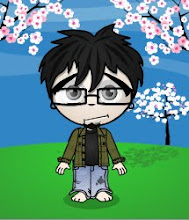In this three-part blog, I will be discussing how to integrate some of the mechanics of the FATE 3.0 system into the Pathfinder RPG. I will be referencing the FATE 3.0 system as presented in The Dresden Files Roleplaying Game: Your Story (published by Evil Hat Productions). If you don't already own this game, you can get a copy here. I will also be referencing two books from the Pathfinder Roleplaying Game (published by Paizo Publishing): the Core Rulebook and the Advanced Player's Guide. Though all of these items are covered by the Open Gaming License, I will not be reproducing rules text, merely commenting on the printed rules themselves, so if you're interested in implementing these ideas, you'll copies of the relevant books in order to do it.
A quick word of warning before I go any further: FATE is much lighter and more cinematic on rules than Pathfinder is. These ideas add a lot of storytelling elements into the character creation and play of the Pathfinder system, so if your group is more about numbers and tactics (with which there is nothing wrong), you may not want to use them. In fact, once it gets down to the game master and even other players invoking another character's aspects, things could get chilly if your group is more interested in gaining every possible advantage in every situation than they are in making a good story. You have been warned.
There are four little words that are integral to creating FATE characters: "Character Creation Is Play." It's a pretty simple little maxim and, looking back, one that I've always tried to play by, but seeing it in print can really drive the point home. There's nothing more frustrating for a game master than starting a campaign only to find that the players have all made characters that would realistically have little or nothing to do with one another. In The Dresden Files RPG, the first step in character creation is actually collaboratively creating the city in which the game will be set. While that's a great tool for Pathfinder (and something that can certainly be tried if you want to get more advanced), in this case we're going to assume that the GM has a campaign idea in mind, and will relate the basic setup to the players.
The upshot is that your group should spend at least the first part of their first session creating characters TOGETHER. As character creation unfolds, each player will have a chance to come up with a bit of his backstory, and will have other characters participate in that backstory as well as participating in the backstories of others. But, before we get to that part, let's talk about Aspects.
Aspects are simple phrases that describe and define your character. It might be something as simple as "Elven Wizard," or something as intriguing as "Seeking Revenge for the Death of His True Love." Each character will have seven aspects, determined by his high concept, his trouble, and by the five phases of character development. This part of character creation can be done before or after normal Pathfinder character creation. Either way has advantages and disadvantages. You, as the GM, can make that decision yourself, or discuss it with your players. Personally, I would choose to do it beforehand.
You character's high concept is a nutshell conceptualization of your character. Most everyone who's played a roleplaying game has, at one time or another, in one way or another, already come up a high concept. Don't believe me? Does this sound familiar?
GM: So, what's everyone playing?
Player 1: I'm a Neutral Good Human Skill-based Rogue.
Player 2: I'm the most beloved Gladiator in the Slave Pits of D'Huun!
Player 3: I'm a Taranthian Bounty Hunter
Player 4: I'm a Wizard who is seeking forbidden knowledge
Player 5: I'm an Follower of the Old Ways, traveling to spread the word and keep them alive.
Player 6: I'm a Bard.
Right? Right. At it's most basic, your high concept can be your race or class or a combination, but it might include more detail. All of the above are perfectly fine examples of a high concept.
Your high concept is also your first aspect.
Your second aspect will be determined by your trouble. Your trouble is something (or even someone) in your life who complicates things. Perhaps you are in debt to a powerful organized crime figure, or you have an truly insatiable curiosity that is constantly getting you into tight spots, or you're a jinx. Maybe you have a child to take care of, or a bounty on your head, or you doubt your faith. By no means is your trouble the only complication in your life, but it is the one that truly defines you.
The most important thing to remember about your high concept and your trouble (indeed, about ALL of you aspects) is that they provide NO mechanical benefits in and of themselves, but will be used as a way to move the story, motivate your character, and get access to things that will provide mechanical benefits.
Next time, I'll go over determining the rest of your aspects, including your character's first story, and how to co-star in other characters' stories. Then, in the third installment, I'll go over how to use your aspects in conjunction with Pathfinder's hero point system.
Subscribe to:
Post Comments (Atom)

No comments:
Post a Comment